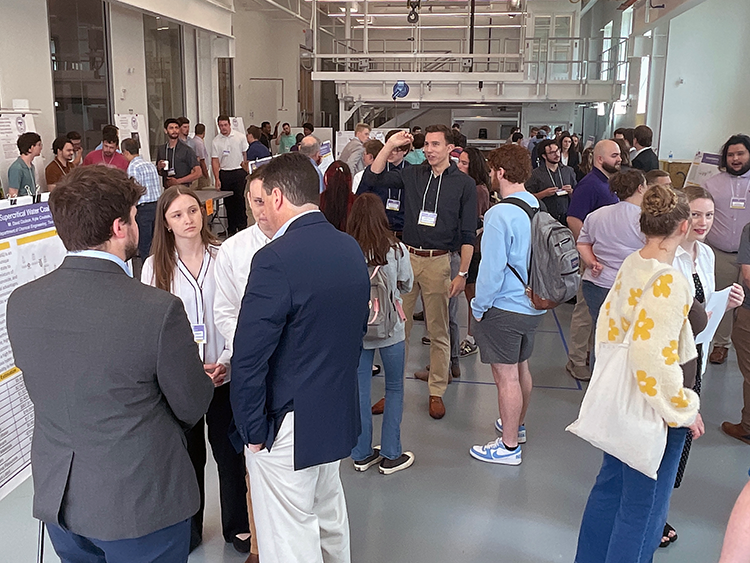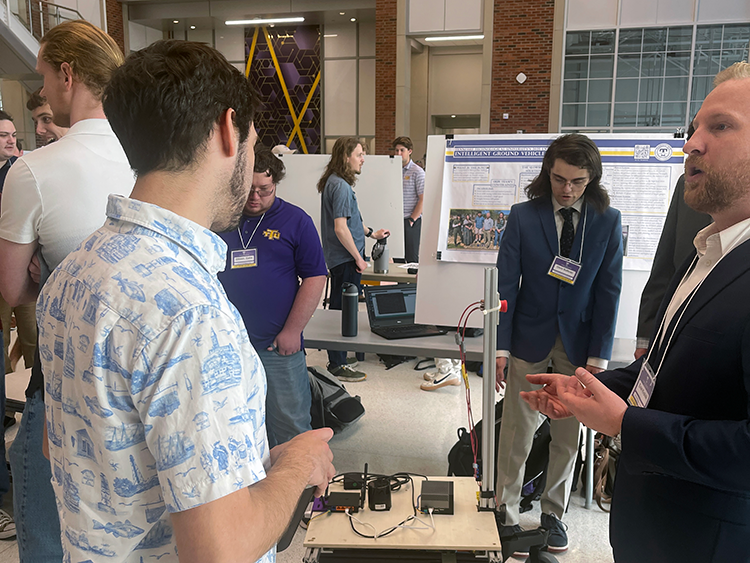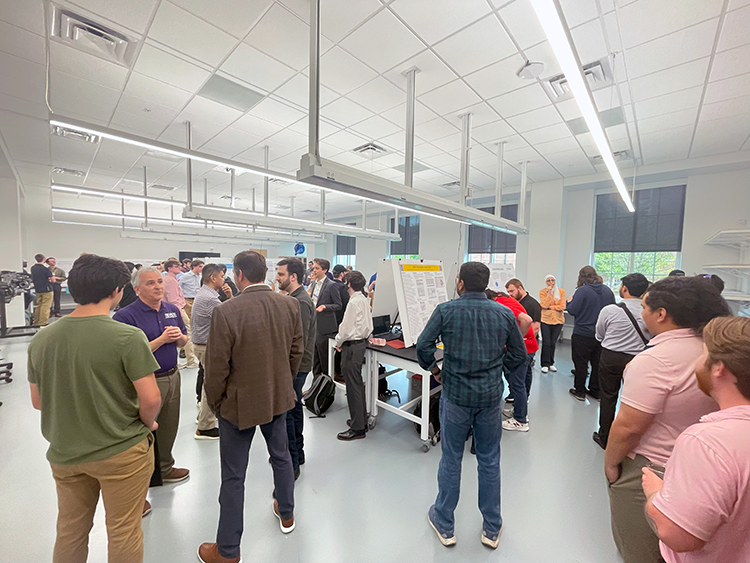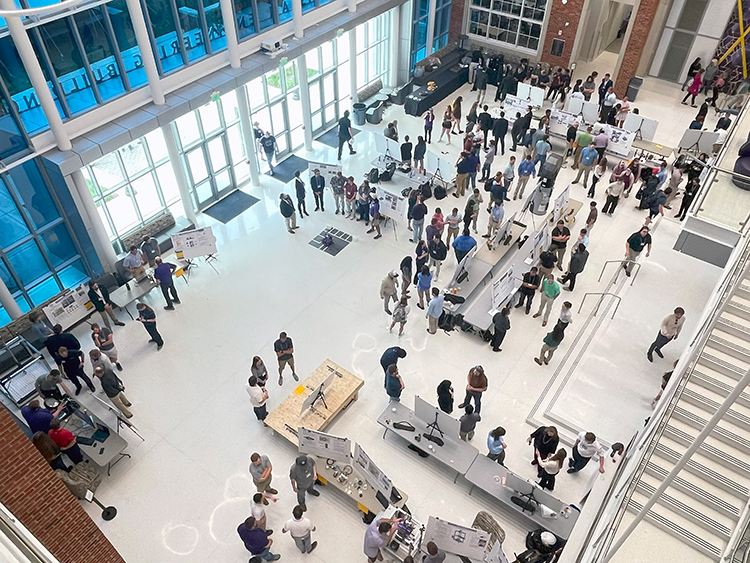Fall 2025 Senior Design Expo
12/04/2025 at 11:00 AM01:00 PM
Join us as our graduating senior engineering and computer science students showcase their capstone projects and present innovative solutions to real-world challenges Thursday, Dec. 4, 2025 from 11 a.m. to 1 p.m. in the Ashraf Islam Engineering Building Atrium located at Tennessee Tech University, 1021 Stadium Drive, Cookeville, TN.
Be sure to visit Tech’s ‘Visitor Parking’ web page to find the closest available parking.
Industry Partners: Get Connected! Sign up here.
Students participating in the design expo:
Find resources to help you with your poster design and printing here.
Fall 2025 Senior Design Project and Team Information by Department
Fall 2025 Project Display Floor Plan will be posted soon!
Questions? Call (931) 372-3172 or email engineering@tntech.edu.
What is Capstone?







When you are nearing the end of your undergraduate or graduate program, your advisor will be talking to you about your Capstone Project. A capstone project is intended to apply all of the knowledge and skills you’ve gained over a college career in one assignment.
Although the projects do showcase your educational accomplishments, they are more about demonstrating that you know how to learn. They are intended to encourage students to use the critical thinking skills they have acquired through their degree programs to solve problems.
Benefits to Students
- Hands-on experience solving a complex real-world problem in an agile, team environment —skills necessary for success.
- Gain necessary exposure to bridge the gap between student and professional.
- Gain experience applying engineering knowledge to solve industry problems.
- Understand and learn importance of time and budget constraints.
Civil and Environmental Engineering
- » Warehouse X: New Buildings and Site Development
Team Members: Collin Latzsch, Grace Butler, Jordan Gentry, Kaylyn Eckel, Ryan Tucker, Ryan Hall
Mentors: Bubba Ingram, Ingram Civil Engineering Group
Project Overview: Develop civil site engineering construction documents for two new buildings for Warehouse X located on property at 330 Homestead Rd, 332 Homestead Rd, and 336 Homestead Rd in Nashville, Tennessee. The existing property is a total of 3.62 acres in size which currently consists of open green space and existing residential structures to be demolished as part of the project. The property is zoned CS.
- » LogiCore Corporate Headquarters
Team Members: Avinash Patri, Blake Benson, Cade Merryman, Joshua Davis, Rebecca Ramsey
Mentors: Stephen Cotton, American Structurepoint, Inc. and Jack Southard, Jack Southard Company
Project Overview: Develop a site for the LogiCore Corporation located just outside of Huntsville, AL. LogiCore delivers comprehensive Systems and Software Engineering services, System Design & Development Information Technology solutions, Program Support services and Life Cycle Logistics services to Department of Defense, Government, and commercial clients in the Continental United States and outside the Continental United States. The Huntsville location will be used for LogiCore’s Corporate headquarters.
- » I-65 Interchange at June Lake BoulevardWilliamson County, TN
Team Members: Carson Haynes, Emiliano Roque Hernandez, Nick Wampler, Samuel Lewis, Sebastian Aguirre
Mentors: Zach Farris, Neel Schaffer
Project Overview: Develop design plans for a new diverging-diamond interchange on Interstate 65 at/or near L.M. 2.62 in Spring Hill, Williamson County, TN and roadway (June Lake Boulevard) extensions to near the existing intersection with Buckner Road at Buckner Lane to the west and Lewisburg Pike (US-431/SR-106) to the east.
- » U.S. 64 (S.R. 40) Road Widening and Cloud Branch Bridge Replacement in Polk County,
TN.
Team Members: Adam Pipkin, Alex Peeler, Caleb Pinkerton, Dustin Wilson, Garrett Crouch
Mentors: Justin Eckel, STV, Inc.
Project Overview: Design of approximately 4,600 feet of a roadway widening and multiuse path on U.S. 64, from Welcome Valley Road to 0.15 mile east of the bridge over Cloud Branch in Polk County. The Project includes replacing the existing bridge, widening the existing road to 3 lanes, and construction of a multiuse path along the corridor.
Computer Science
- » Baxter Fire Department
Team Members: Mckye Shrum, Damien Owen, Jacob Smith, Michele Mackeown, Meshal Alotaibi, Elijah Beatty
Mentor: Chief Matt White, Baxter Fire Department
Project Overview: The team developed a fully functional website for the Baxter Fire Department in Baxter, Tennessee. The site strengthens community engagement and streamlines the process for creating burn permits, eliminating the need for physical paperwork. It includes a Content Management System (CMS) that allows easy updates to personnel information, calendars, and other features, as well as the ability to suspend burn permits when necessary—without requiring technical expertise.
- » Briding Hope
Team Members: Cole Garrett, Parker Lovin, Grayson Mosley, Dawson Strunk, Kyle Davis
Mentor: Mrs. Donna Brown, Baxter First Church of God
Project Overview: Bridging Hope is a web application which helps churches/charities coordinate aid to their communities. The application's primary function is to help prevent the occurrence of "double dipping," a practice in which some recipients may exploit organizations by receiving the same aid from multiple parties. Our application helps prevent this activity by logging aid history by recipient and household to ensure all aid is legitimate. Beyond this primary function, Bridging Hope also helps organizations to coordinate aid through features such as a calendar and bulletin board.
- » Cookeville Police Department
Team Members: Sebjin Kennedy, Adyson Rollins, Joshua Mangrum, Michael Clinton, Jillian Wheeler
Mentor: Chief Scott Winfree, Cookeville Police Department
Project Overview: Students collaborated with the Cookeville Police Department (CPD) development team to design and implement a notification system integrated with the LADP (Active Directory) for the Leave Module. The system features a shared calendar that provides visibility into all scheduled leave. Students configure automated notifications that send leave requests to supervisors and deliver approval or denial responses via email. This project demonstrates the ability to develop practical solutions that streamline leave management, enhance transparency, and improve communication within CPD operations.
- » Joy for Jesus
Team Members: Levi Spellmeyer, Daniela Vela Hernandez, Devon Russell, Collin Chappell, Benjamin Byerly
Mentor: Jennifer Cox
Project Overview: The Joy From Jesus capstone project is a web-based pseudo point of sale and registration page developed to mimic a cellular application. The system will replace existing patchwork methods used to track inventory manually, making it more efficient and easier to track toy donations/purchases as well as their physical location once items are stored on site. This application also includes a guest management system where beneficiaries can submit their contact information so that board members of the non-profit are able to contact the families looking for assistance. This application is a combination of a React frontend, Express backend, and a MariaDB database. Overall, the goal of developing this website is to assist Joy From Jesus, by providing a streamlined alternative they can use to track inventory, keep up with those looking to receive assistance, maintain accurate records, and serve their community to the best of their ability.
- » Tennessee Tech Department of Music
Team Members: Travis Retallack, Allison Housley, James Eldridge, Elijah Ramsey, Benjamin Barlow, Jack Siegers
Mentor: Dr. Colin Hill, School of Music
Project Overview: A student development team created a custom adjudication platform for the Tennessee Tech School of Music using Microsoft 365 applications—SharePoint, Power Automate, Microsoft Teams, Microsoft Forms, and Bookings—to streamline jury scheduling and evaluation. The system integrated seamlessly with TNTech’s infrastructure, allowing faculty and staff to manage forms, evaluations, and records through a dedicated Teams channel linked to SharePoint, while automated workflows routed submissions to secure Excel sheets. Students accessed a standalone jury website to book jury slots, submit repertoire details, and receive automated confirmations and reminders. This digital-first solution delivered a cost-effective, sustainable alternative to external platforms by leveraging TNTech’s existing Microsoft ecosystem.
- » Stonecom Communications
Team Members: Sierra Stewart, Abby Jarvis, Majed Alkharaa, Kaleb McMorrow, Weston Kelly, Chance Tate
Mentor: Marcia Lorance, Stonecom Radio
Project Overview: The project is a full-stack web application developed for Stonecom Radio to streamline listener giveaways, prize tracking, and staff operations. The platform enables staff to create and manage giveaways, prizes, and contestant entries with ease. Key features include automated email notifications to winners and alerts to staff for critical updates such as low prize inventory and expired prizes. By centralizing these processes, the application enhances operational efficiency and ensures a smooth, engaging experience for both listeners and staff.
- » DEVCOM
Team Members: Ryan Naleway, JP Ognibene, Celia Hough, Harrison Simpson, Graham Wheeler, Gabriel Adams
Mentor: Elias Brady, DoD
Project Overview: The CirceSoft web interface is designed for minimal interaction with the CirceBot, a semi-autonomous military robot that deploys communication wires in dangerous zones. Its robust user interface primarily focuses on situational awareness, offering a visualization of the CirceBot's path, relative position, and status data like path completion and connectivity. Operators maintain simple, essential control capabilities via the header, which include starting/stopping traversal, loading or importing routes with waypoints, and conducting an emergency stop. CirceSoft also allows users to manually place objects via a collision mask, and shows optimized path options, considering factors like obstacles and maximum cable length, simplifying the operator's task of keeping the mission on track.
- » Briding Hope
Team Members: Elijah Plattner, Michael Albert, Preston Harberts, William Collier, Joseph Wright
Mentor: Seth Williams, Tennessee Tech University
Project Overview: Food pantries face significant operational challenges in managing inventory and tracking client information efficiently. This project presents a comprehensive inventory management system designed specifically for food pantries, developed in partnership with Bridging Hope. Built using React and Node.js, the system addresses two critical needs: streamlining administrative workflows and providing secure, intuitive client tracking. The platform also features advanced reporting capabilities that deliver real-time data, historical trends, and forecasting analytics to enable more accurate restocking decisions and operational insights. Through user testing with food pantries, we validated the system's usability and effectiveness, receiving overwhelmingly positive feedback on both functionality and interface design. The project culminated in coordination with partner food pantries to establish the groundwork for future implementation for real-world deployment, demonstrating the system's readiness to improve operational efficiency across non-profit food pantries.
- » Dugeons & Detections
Team Members: John Frisbee, Avery Richardson, Hao Ho, Jaden Cunningham, Aidan Gillespie
Mentor: Brian Bleck, ARCS Aviation
Project Overview: A Unity app for Android that uses Machine Learning to Recognize and name (DnD) Minifigurines
- » Responder Ready
Team Members: Nicolas Murgas, Nicholas Fish, Kaylee Miller, Brady Reynolds, Axel Lopez Mendoza
Mentor: Dr. Derrick Edwards, Tennessee Tech University
Project Overview: A mobile app that leverages psychology to assist firefighters with their mental and physical health.
- » Mighty Lube
Team Members: Gavin Davis, Lucas Dowlen, Devan Hoover, Noah Gregory, Gavin Norris
Mentor: Anthony Brown, Mighty Lube
Project Overview: A web-based application designed for internal use by the Mighty Lube company. The application allows users to display, edit, and update pending orders.
- » FinTech Warriors
Team Members: Chandler Case, Daniel Rodriguez, Deanna Sola, Aziz Alamri, Daniel Selvidge
Mentor: Dr. Alma Nunez, Tennessee Tech University
Project Overview: A web-based application that teaches essential personal finance skills through interactive tools and guided learning. Designed to help students and young adults build financial literacy through engaging, hands-on experiences.
- » Field Missions of Tennessee
Team Members: Thomas Robertson, Garrett Mastin, Adrian Gonzalez, Gavin Walker, Claudi Nething
Mentor: Sam LeFave, Field Missions of Tennessee
Project Overview: With many in our communities struggling to have proper access to healthcare, Field Missions works to bridge the gap by partnering with volunteers and health professionals to provide free services to those who need it most. This project modernizes and centralizes Field Missions’ operations into a single, user-friendly web application. Developed using NodeJS, HTML, Bootstrap, CSS, and JavaScript, the platform delivers a redesigned public website for community engagement and an integrated dashboard for administrators and volunteers. Through this system, Field Missions can more efficiently manage events, volunteer coordination, and public outreach, enabling their ability to better serve and provide care for all.
Electrical and Computer Engineering
- » DEVCOM Cable Installation Robot
Team Members: Kamden Edens, Connor Graves, Wayne Marcrum, Cooper Mcfarlane, Evan Winnie
Mentor: Dedra Moore, United States Army Combat Capabilities Development Command DEVCOM)
Project Overview: Modern military operations rely heavily on secure communication networks, often requiring the rapid deployment of cables in contested environments. The Cable Installation Robot for Contested Environments (CIRCE) is an autonomous robotic system designed to lay communication cables safely and efficiently in high-risk zones without exposing human operators to danger. CIRCE leverages advanced path planning algorithms and obstacle detection to navigate complex environments while optimizing cable placement. The robot integrates a sensor subsystem, including various detection methods and GPS-denied localization methods, with the goal of ensuring robust performance in specified test conditions. CIRCE aims to enhance operational efficiency and battlefield survivability, representing a significant advancement in autonomous military engineering applications.
- » Formula SAE Electric Battery System
Team Members: Maddox Cagle, Jordan Davis, Marisol Miranda Martinez, Mackenzie Raleigh
Project Overview: This senior design project hopes to develop a custom Battery Management System (BMS) and lithium-ion battery cell battery for the Formula SAE Electric Car that optimizes performance, safety, and efficiency in a competitive racing environment. The BMS is the main control device that monitors and balances the state of charge, temperature, and health of the battery pack while ensuring adequate cell balancing and system protection. The battery portion is primarily needing to turn the motor to show proof that the function of the cells is better than the Zero Motorcycle battery in the specific and constraints. The project aims to reverse restrictions inherent to current off-the-shelf options, which are not necessarily the power-to-weight ratio or cost-effectiveness necessary for competition at the Formula SAE level. The group wants to design and implement a battery system that is light, inexpensive, but high-performance and at least equal to, if not superior to, the current Zero Motorcycle battery being used by the group. Primary objectives are to achieve safe and stable energy source, guarantee compliance with the Formula SAE Electric rulebook, and demonstrate state-of-the-art monitoring features to prevent risks such as overcharging, overheating, or electrical faults. The envisioned system integrates multidisciplinary engineering principles encompassing electrical engineering, embedded control, and heat management, all in accordance with ethical, economic, and environmental standards. Upon completion, the project will include a fully functioning BMS in the race car's electrical system that supports data-driven performance optimization and safe running during the duration of the competition. In general, this project further supports Tennessee Technological University's ongoing support of electric vehicle development and education in preparation for future engineers to take leadership positions within sustainable automotive technologies.
- » Drone Tracking
Team Members: Mandy Bacon, Brett Ballew, Tyler Bare, Erich Krepps, Gabrielle Renfroe
Project Overview: The objective of this project is to design a campus-wide drone tracking system for Tennessee Technological University campus police to detect unauthorized drone activity using Remote ID signals transmitted over Wi-Fi and Bluetooth. This includes a real-time detection platform with a secure web interface to support drone tracking authorization management, and alert notifications.
- » Modular Greenhouse Sensors
Team Members: Mohammed Almehmadi, Michael Feiel, Henry Hurst, Duy Tran
Project Overview: The purpose of our greenhouse sensor units is to provide Tennessee Tech's biology department with a cost-effective and modular solution to obtain gradiant data inside a greenhouse. The ability to obtain data for oxygen, CO2, pressure, temperature, and humidity will help the biology department conduct their own analysis pertaining to the research done with plants in a greenhouse.
Manufacturing and Engineering Technology
- » INOAC Spoiler Assembly Conveyor Time Studies and Improvements
Team Members: Treston Crump, Marco Nashed, Pico Purnell, Joseph Ryan
Mentors: Carter Shunk, INOAC
Project Overview: There is a demand for spoilers on cars. Spoilers are mostly wanted for cosmetic purposes, but they also serve to increase a car’s speed by reducing drag, lift and wind resistance. They also increase down force and improve stability. However, due to safety regulations after several incidents of optimized spoilers falling off cars, spoilers mostly retain their appearance over function. The main objective with INOAC is to perform very comprehensive time studies in three different assembly programs to make sure that we have accurate standard times for the critical components like the clips, screws, and CHMSL’S. The outcome of this project is expected to contribute more consistent product performance and through observation and analytics and collaborative problem-solving the project will have made actionable insights for INOAC’s manufacturing processes.
- » Mechanism for Loading and Flipping on Enameling Line
Team Members: Derek Adkins, Conner Bailey, Isaac Dortch, Kaylee Easter, Noah Tripucka
Mentors: Brad Wood, Bradmark Industrial Coatings LLC
Project Overview: Bradmark has a need to automate the loading and flipping of parts on one of their enamel coating lines. The current enameling line has four employees on it with two loading parts and two flipping parts on the line right before the second coating booth. Previously, manpower was used in the loading and flipping process due to the complexity and cost of automation. This is an inefficient utilization of manpower and should be automated. By automating this process, Bradmark can reduce costs and streamline efficiency.
- » Proximity Sensor Check Station
Team Members: Amber Widdoes, Hope Flores, Shane Bray, Aiden Hansen, Yossif Mikhail
Mentors: Amber Widdoes, Hutchinson
Project Overview: In today's industrial environment, there is a reliance on proximity sensors for operational performance. The functionality of the proximity sensor is crucial to minimizing downtime. The main functions are to detect the presence of objects, determine machine position, and maintain safety conditions. If a sensor fails, it can bring a production line to a stop, leading to costly delays and reduced productivity. When using proximity sensors on worksites, it is crucial that every sensor works. Hutchinson needs a check station/device to check the functionality and type of sensor, whether they are Negative Positive Negative (NPN), Positive Negative Positive (PNP), or 120 Volts. In this project, the check station is designed to use a standard power enclosure that is small enough to carry, this would allow the device to be used anywhere.
- » PLC Controlled Automatic Wire Cutter
Team Members: Jeremiah Hamby, Kyle Hauck, Jakeb Newman, Noah Perez, Will Tippett
Project Overview: There is a need in the electrical lab for an automated wire cutter. Previously, every piece of wire required for students’ labs had to be cut by hand, which was both repetitive and time consuming. Typically, Dr. Baswell would spend hours preparing wires for all the students. This task prevented him from focusing on other important responsibilities. Additionally, when many sections of wire were needed at once, the workload became overwhelming, and the process could delay the start of lab activities. Now, automation provides an efficient solution to this problem. By using an automated wire cutter, large quantities of wire can be cut quickly and consistently, ensuring uniform lengths and reducing waste.
- » Pineapple Roller to Keep Get a Good Tasting Pineapple
Team Members: Jason Roach, Andrew Barnett, Robert Maxsimos, John Maxcimos
Project Overview: There is a need in the modern household for a way to ensure that each pineapple you get is the best pineapple you have ever tasted. In the past you would have had to buy an unripe Pineapple from the store and let it sit in your kitchen and wait until it turned the perfect shade of yellow of your liking for you to enjoy it. With newfound information you can set the pineapple on its side and let the sweet juices and sugars flow with gravity to the bottom of the horizontal pineapple. With this newfound information that means you would have to rotate the pineapple clockwise or counterclockwise a specific amount each day and you would have to remember when the last time you rotated it and how much rotated it last. There is a solution to this problem with the Sweet Turn which is a Pineapple Roller/ Pineapple rotator. The Sweet Turn assists the average family with ensuring the fresh and sweet taste of each pineapple.
Mechanical and Nuclear Engineering
- » Suspension Simulator
Team Members: Greogory Brown, Dylan Echols, Charlie Ewing, Jordan Serrano Gutierre
Project Overview: Team is developing a quarter car 2 degree of freedom suspension simulation system.
- » Air Leak Detection
Team Members: Kylan Dalton, Isaac Lagault, Jackson Wheller, Christopher Lottridge
Project Overview: Team is investigating the use of vibration signature of a pipe to detect an air leak.
- » Aerodynamic Characteristics Modeling
Team Members: Wes Clark, Mia Duke, Joshua Matson, Ryan McBride
Project Overview: Team is developing procedures for determining the aerodynamic charateristics of aircraft using OpenVSP.
- » Steering Simulator
Team Members: Zac Campbell, Charlie Crenshaw, Kenny Decker
Project Overview: Team is developing a fly by wire steering simulator adapted from a vehicle sterring and front suspension system.
- » Flight Simulator
Team Members: Cullan Callahan, Derek Jones, Carson Mckellar, Jacob Rodriguez
Project Overview: Team is developing a flight simulator based on tools in the Matlab Aero Blockset. The simulator will allow the team to model the impact of changes is aerodyanmic charateristics on vehicle perfromance.
- » Pep Truck Modernization
Team Members: Logan Adams, Bilkuei Haar, Owen Massey, Kevin Molina-Espinoza
Project Overview: Team is working on a continuing project to modernize the Pep Truck with an electric drivetrain and structurally safe frame.
- » Greeting Robot
Team Members: Emily Hembree, Zakary Henson, Jaden Saillard
Project Overview: Team is developing a robot that can autonomusly guide visitors to a specific room.
- » E Formula
Team Members: Braxton Baumann, Chase Byrant, Seth Goan, Charles Shamburger
Project Overview: Team is adapting an eteric drivetrain to an existing SAE Formula car.
- » Cable laying robot
Team Members: Pishoy Isaac, Addie Johnson, Robert Lythgoe, Micah Page
Project Overview: Team is developing a robot that can autonomusly deploy a cable in an outdoor environment without the use of GPS for guidance.
Senior Design Expo Design Project Archives
›› 2025 Spring Senior Design Expo
›› 2024 Fall Senior Design Expo
›› 2024 Spring Senior Design Expo
›› 2023 Fall Senior Design Expo
›› 2023 Spring Senior Design Expo
›› 2022 Fall Senior Design Expo
›› 2022 Spring Senior Design Expo

